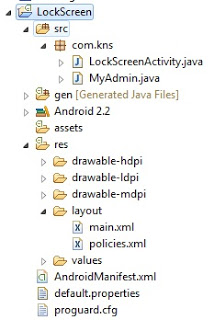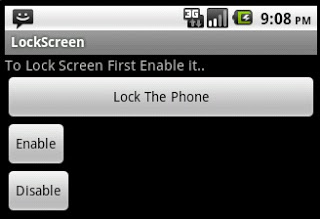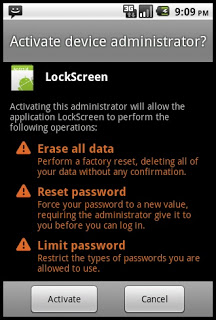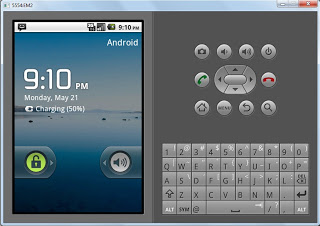Is there any one that can help me with a code to set a password to lock the screen ? thx
Use this code in your App, it works for me:
DevicePolicyManager devicePolicyManager =
(DevicePolicyManager) getSystemService(Context.DEVICE_POLICY_SERVICE);
ComponentName demoDeviceAdmin = new ComponentName(this, name of activity);
devicePolicyManager.setPasswordQuality(
demoDeviceAdmin,DevicePolicyManager.PASSWORD_QUALITY_UNSPECIFIED);
devicePolicyManager.setPasswordMinimumLength(demoDeviceAdmin, 5);
boolean result = devicePolicyManager.resetPassword("123456",
DevicePolicyManager.RESET_PASSWORD_REQUIRE_ENTRY);
Toast.makeText(this, "button_lock_password_device..."+result, Toast.LENGTH_LONG).show();
Check this . This worked for me.
LockScreenActivity.java
package com.kns;
import android.app.Activity;
import android.app.ActivityManager;
import android.app.admin.DevicePolicyManager;
import android.content.ComponentName;
import android.content.Context;
import android.content.Intent;
import android.os.Bundle;
import android.util.Log;
import android.view.View;
import android.view.View.OnClickListener;
import android.widget.Button;
public class LockScreenActivity extends Activity implements OnClickListener {
private Button lock;
private Button disable;
private Button enable;
static final int RESULT_ENABLE = 1;
DevicePolicyManager deviceManger;
ActivityManager activityManager;
ComponentName compName;
@Override
public void onCreate(Bundle savedInstanceState) {
super.onCreate(savedInstanceState);
setContentView(R.layout.main);
deviceManger = (DevicePolicyManager)getSystemService(
Context.DEVICE_POLICY_SERVICE);
activityManager = (ActivityManager)getSystemService(
Context.ACTIVITY_SERVICE);
compName = new ComponentName(this, MyAdmin.class);
setContentView(R.layout.main);
lock =(Button)findViewById(R.id.lock);
lock.setOnClickListener(this);
disable = (Button)findViewById(R.id.btnDisable);
enable =(Button)findViewById(R.id.btnEnable);
disable.setOnClickListener(this);
enable.setOnClickListener(this);
}
@Override
public void onClick(View v) {
if(v == lock){
boolean active = deviceManger.isAdminActive(compName);
if (active) {
deviceManger.lockNow();
}
}
if(v == enable){
Intent intent = new Intent(DevicePolicyManager
.ACTION_ADD_DEVICE_ADMIN);
intent.putExtra(DevicePolicyManager.EXTRA_DEVICE_ADMIN,
compName);
intent.putExtra(DevicePolicyManager.EXTRA_ADD_EXPLANATION,
"Additional text explaining why this needs to be added.");
startActivityForResult(intent, RESULT_ENABLE);
}
if(v == disable){
deviceManger.removeActiveAdmin(compName);
updateButtonStates();
}
}
private void updateButtonStates() {
boolean active = deviceManger.isAdminActive(compName);
if (active) {
enable.setEnabled(false);
disable.setEnabled(true);
} else {
enable.setEnabled(true);
disable.setEnabled(false);
}
}
protected void onActivityResult(int requestCode, int resultCode, Intent data) {
switch (requestCode) {
case RESULT_ENABLE:
if (resultCode == Activity.RESULT_OK) {
Log.i("DeviceAdminSample", "Admin enabled!");
} else {
Log.i("DeviceAdminSample", "Admin enable FAILED!");
}
return;
}
super.onActivityResult(requestCode, resultCode, data);
}
}
MyAdmin.java
package com.kns;
import android.app.admin.DeviceAdminReceiver;
import android.content.Context;
import android.content.Intent;
import android.content.SharedPreferences;
import android.widget.Toast;
public class MyAdmin extends DeviceAdminReceiver{
static SharedPreferences getSamplePreferences(Context context) {
return context.getSharedPreferences(
DeviceAdminReceiver.class.getName(), 0);
}
static String PREF_PASSWORD_QUALITY = "password_quality";
static String PREF_PASSWORD_LENGTH = "password_length";
static String PREF_MAX_FAILED_PW = "max_failed_pw";
void showToast(Context context, CharSequence msg) {
Toast.makeText(context, msg, Toast.LENGTH_SHORT).show();
}
@Override
public void onEnabled(Context context, Intent intent) {
showToast(context, "Sample Device Admin: enabled");
}
@Override
public CharSequence onDisableRequested(Context context, Intent intent) {
return "This is an optional message to warn the user about disabling.";
}
@Override
public void onDisabled(Context context, Intent intent) {
showToast(context, "Sample Device Admin: disabled");
}
@Override
public void onPasswordChanged(Context context, Intent intent) {
showToast(context, "Sample Device Admin: pw changed");
}
@Override
public void onPasswordFailed(Context context, Intent intent) {
showToast(context, "Sample Device Admin: pw failed");
}
@Override
public void onPasswordSucceeded(Context context, Intent intent) {
showToast(context, "Sample Device Admin: pw succeeded");
}
}
main.xml
<textview android:layout_width="fill_parent" android:layout_height="wrap_content" android:text="To Lock Screen First Enable it.." android:textsize="15sp"></textview>
<button android:id="@+id/lock" android:layout_width="match_parent" android:layout_height="wrap_content" android:text="Lock The Phone"></button>
<button android:id="@+id/btnEnable" android:layout_width="wrap_content" android:layout_height="wrap_content" android:text="Enable"></button>
<button android:id="@+id/btnDisable" android:layout_width="wrap_content" android:layout_height="wrap_content" android:text="Disable"></button></linearlayout>
policies.xml
<?xml version="1.0" encoding="utf-8"?>
<device-admin xmlns:android="http://schemas.android.com/apk/res/android">
<uses-policies>
<limit-password>
<watch-login>
<reset-password>
<force-lock>
<wipe-data>
</wipe-data></force-lock></reset-password></watch-login></limit-password></uses-policies>
</device-admin>
You can have this policies.xml either in layout or in xml folder. Only thing you need to take care is metadata tag in Androidmanifest file.
<?xml version="1.0" encoding="utf-8"?>
<manifest xmlns:android="http://schemas.android.com/apk/res/android" package="com.kns" android:versioncode="1" android:versionname="1.0">
<uses-sdk android:minsdkversion="8">
<application android:icon="@drawable/icon" android:label="@string/app_name">
<activity android:name=".LockScreenActivity" android:label="@string/app_name">
<intent-filter>
<action android:name="android.intent.action.MAIN">
<category android:name="android.intent.category.LAUNCHER">
</category></action></intent-filter>
</activity>
<receiver android:name=".MyAdmin" android:permission="android.permission.BIND_DEVICE_ADMIN">
<meta-data android:name="android.app.device_admin" android:resource="@layout/policies">
<intent-filter>
<action android:name="android.app.action.DEVICE_ADMIN_ENABLED">
</action></intent-filter>
</meta-data></receiver>
</application>
</uses-sdk></manifest>
Before Lock the screen you need to Enable Admin Permission
Then you will get this..
After Enable you will lock screen..like this
http://developer.android.com/guide/topics/admin/device-admin.html
private static DevicePolicyManager dpm =
(DevicePolicyManager)context
.getSystemService(Context.DEVICE_POLICY_SERVICE);
private static ComponentName admin =
new ComponentName(context, DeviceAdminManager.class);
// add password policies you want
dpm.setPasswordQuality(admin, DevicePolicyManager.PASSWORD_QUALITY_UNSPECIFIED);
dpm.setPasswordMinimumLength(admin, 5);
**boolean result = dpm.resetPassword("newPassword", RESET_PASSWORD_WITHOUT_ENTRY);**
check out this website http://blog.stef.be/patternlock. In this website, the implementation of screen lock pattern using javascript, html and css was defined very clearly...Entire code is available since its open source..Hope it wil help you
Android N is not working , See Here
Note: This API has been limited as of N for device admins that are not device owner and not profile owner. The password can now only be changed if there is currently no password set. Device owner and profile owner can still do this when user is unlocked and does not have a managed profile.
© 2022 - 2024 — McMap. All rights reserved.




